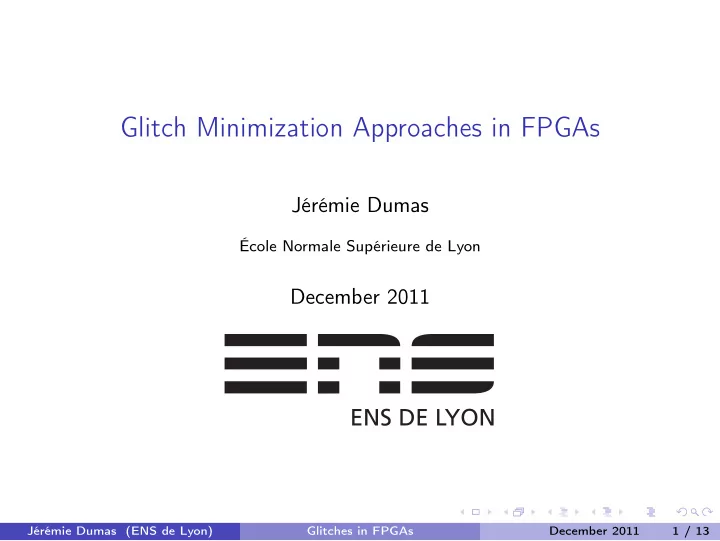

Glitch Minimization Approaches in FPGAs Jérémie Dumas École Normale Supérieure de Lyon December 2011 Jérémie Dumas (ENS de Lyon) Glitches in FPGAs December 2011 1 / 13
Motivations Performance driven algorithms for FPGAs Need for power-efficient methods : alternative goal Embeded technology, increased autonomy, green computing . . . Noise reduction Jérémie Dumas (ENS de Lyon) Glitches in FPGAs December 2011 2 / 13
Definitions Technology mapping, placement and routing Static power versus dynamic power (62 % of total power) Functional transitions versus spurious transitions (glitches) Intertial delay of 0 . 2 ns : smaller glitches are filtered Jérémie Dumas (ENS de Lyon) Glitches in FPGAs December 2011 3 / 13
Approaches GlitchMap, GlitchReroute, GlitchLess Optimizing the technology mapping (GlitchMap) Optimizing the routing (GlitchReroute) Physically inserting new elements (GlitchLess) Blend it together Here : GlitchLess and GlitchReroute. Takes place after routing. Does not alter the length of the critical path. Jérémie Dumas (ENS de Lyon) Glitches in FPGAs December 2011 4 / 13
The Programmable Delay Element Jérémie Dumas (ENS de Lyon) Glitches in FPGAs December 2011 5 / 13
Configuration Models Needed _ Delay ( n , f ) for each input signal f of node n Setting the Added _ Delay ( n , f ) using multiples of i · τ + cte Jérémie Dumas (ENS de Lyon) Glitches in FPGAs December 2011 6 / 13
Adding Delay Elements Experimentation Protocol HSPICE simulation software Versatile Place and Route (VPR) used for routing Parameters prior to configuration : min_in , max_in , num_in . . . Calibrations done with ideal parameters Experiments using LUT with K = 4 , 5 , 6 inputs Jérémie Dumas (ENS de Lyon) Glitches in FPGAs December 2011 7 / 13
Path Balancing A Rerouting Heuristic Graph with delays, Rip-up and re-route like VPR Target delay in range d ± ∆ , with ∆ = 1 2 · intertial _ delay A heuristic for selecting a pair ( s , t ) to reroute Critical path remain unchanged Considers essentially first-level clusters Selection heuristic Favors paths with more influence on the rest of the DAG Defavors paths that need great readjustment Jérémie Dumas (ENS de Lyon) Glitches in FPGAs December 2011 8 / 13
Source to Sink Rerouting (a) Single-edge path (b) Two-edge and recursive Looking for simple paths (without loop). Heuristic approach. Uses Dijkstra’s algorithm. Find paths s � s ′ − t ′ � t . Split the graph in two sets S and T . Two-edges and recursive extensions. Jérémie Dumas (ENS de Lyon) Glitches in FPGAs December 2011 9 / 13
Some Numbers Average Reductions Power savings : ≈ 18 % for GlitchLess and ≈ 11 % for GlitchReroute. Glitching activity : − 91 % for GlitchLess and − 27 % for GlitchReroute. Ideal dynamic power saving of 22 . 6 % . Jérémie Dumas (ENS de Lyon) Glitches in FPGAs December 2011 10 / 13
Downsides Power overhead, common in both scheme. Area overhead for GlitchLess ( ≈ 5 % ). Delay overhead for GlitchLess (from ≈ 0 . 2 % to ≈ 2 % ). Jérémie Dumas (ENS de Lyon) Glitches in FPGAs December 2011 11 / 13
Moral of the Story Dynamic power reduction techniques During the technology mapping, the routing process, or afterwards. Mapping : cut-enumeration based techniques. Low-power clustering. Problems are NP-Hard. Experimental protocol Simulation, models for signal propagation and power consumption . Estimating the switching activity with a probabilist approach. Multi-dimensional calibration by varying one parameter at a time. Jérémie Dumas (ENS de Lyon) Glitches in FPGAs December 2011 12 / 13
Thank you for your attention. Feel free to ask your questions. Jérémie Dumas (ENS de Lyon) Glitches in FPGAs December 2011 13 / 13
Recommend
More recommend